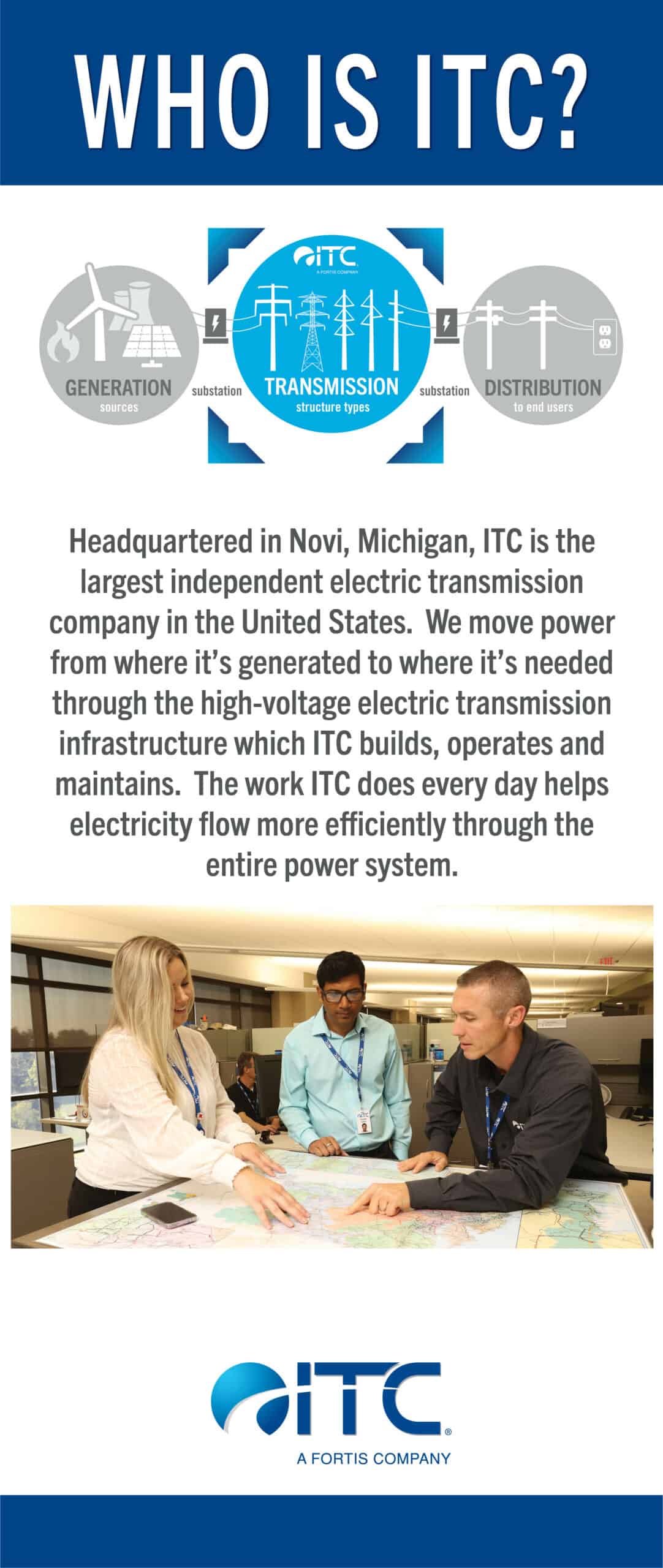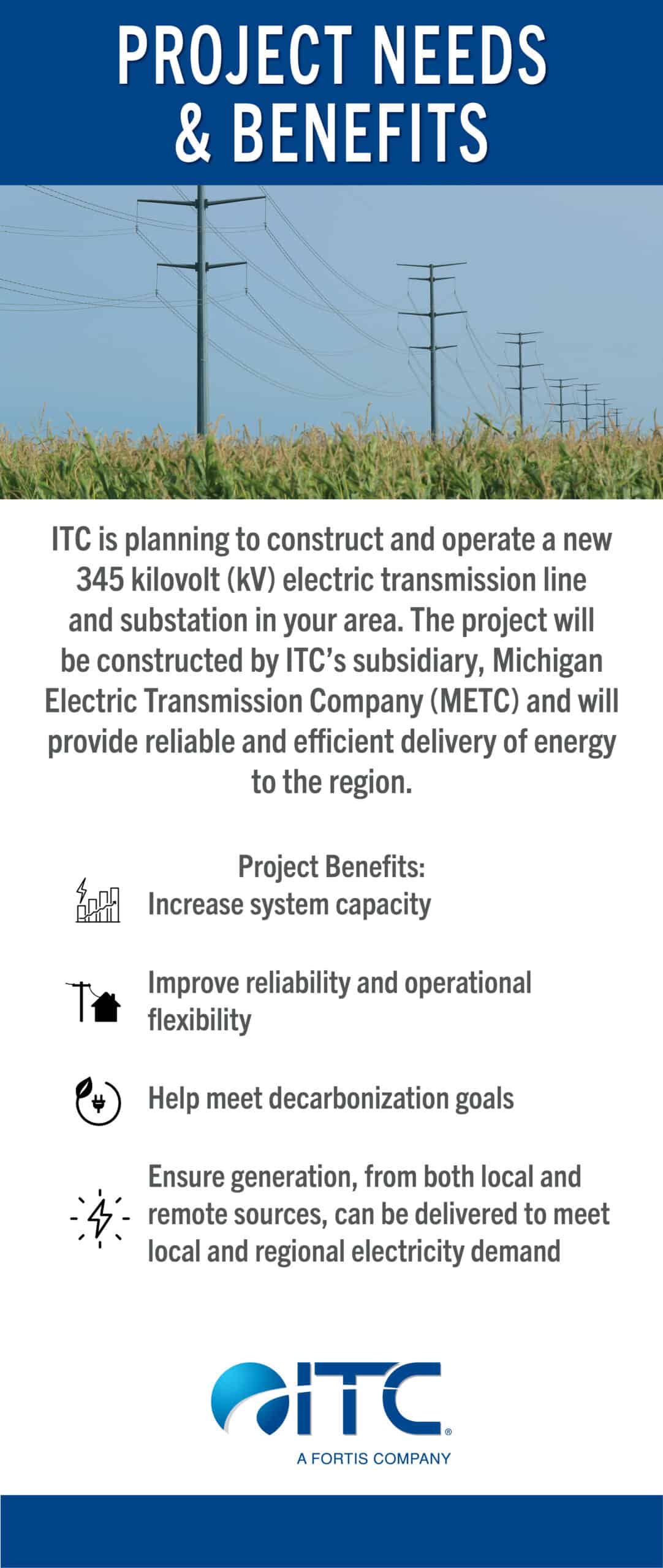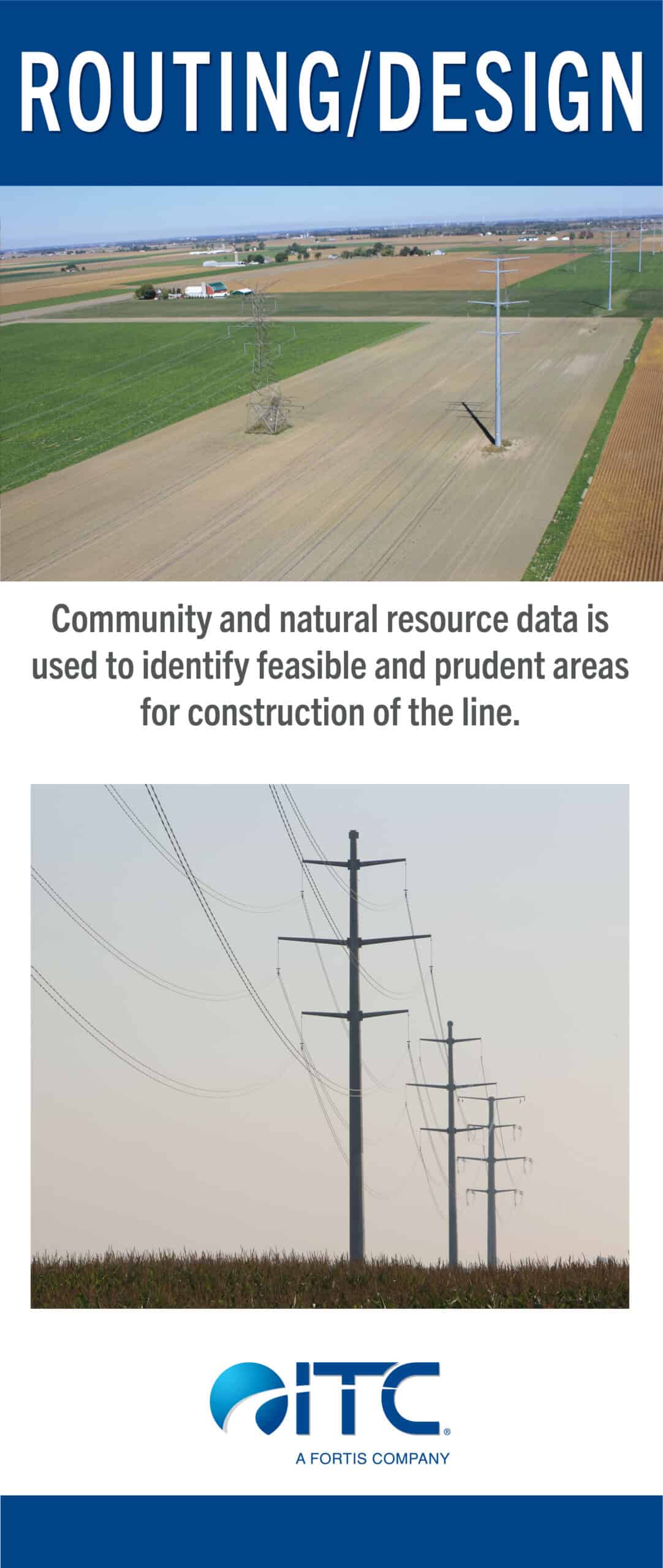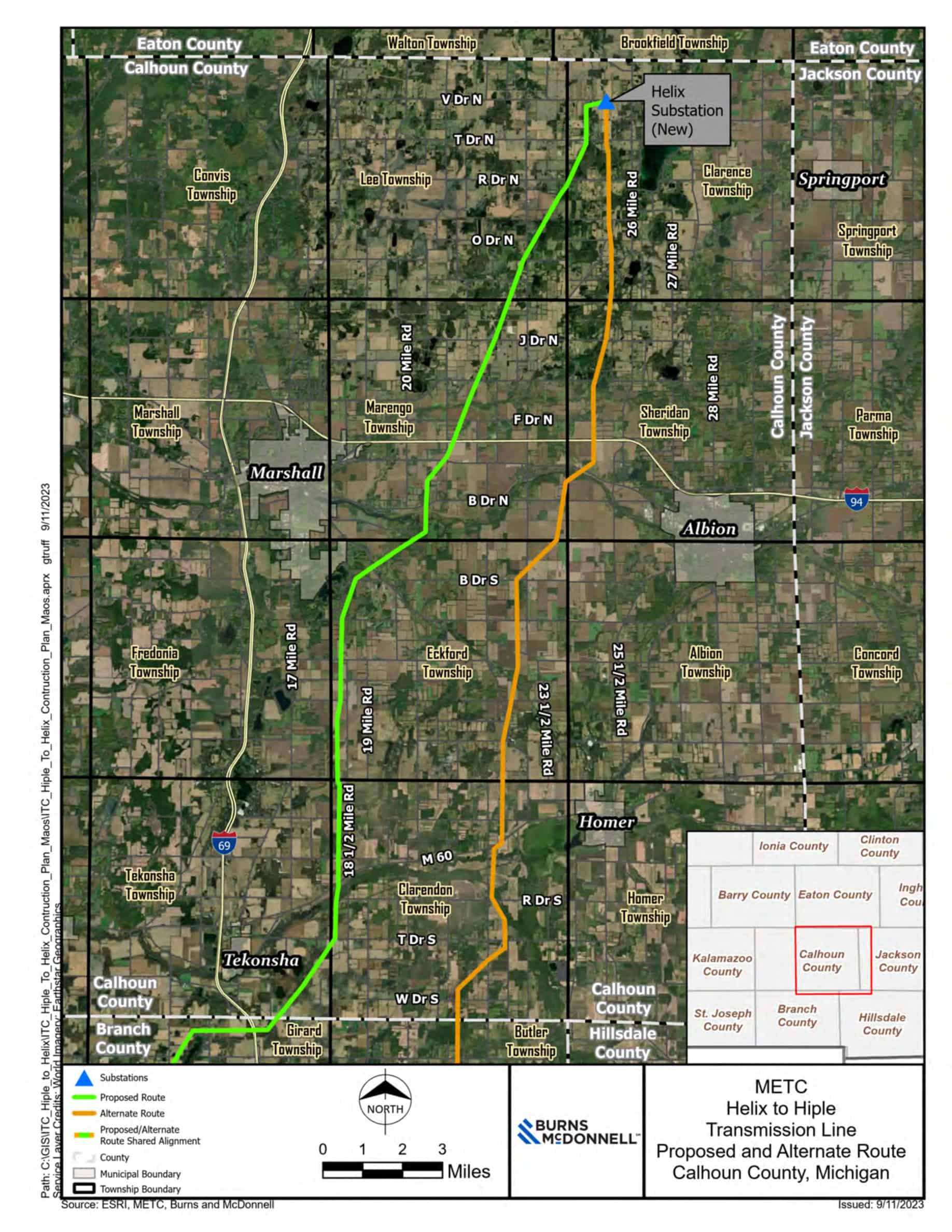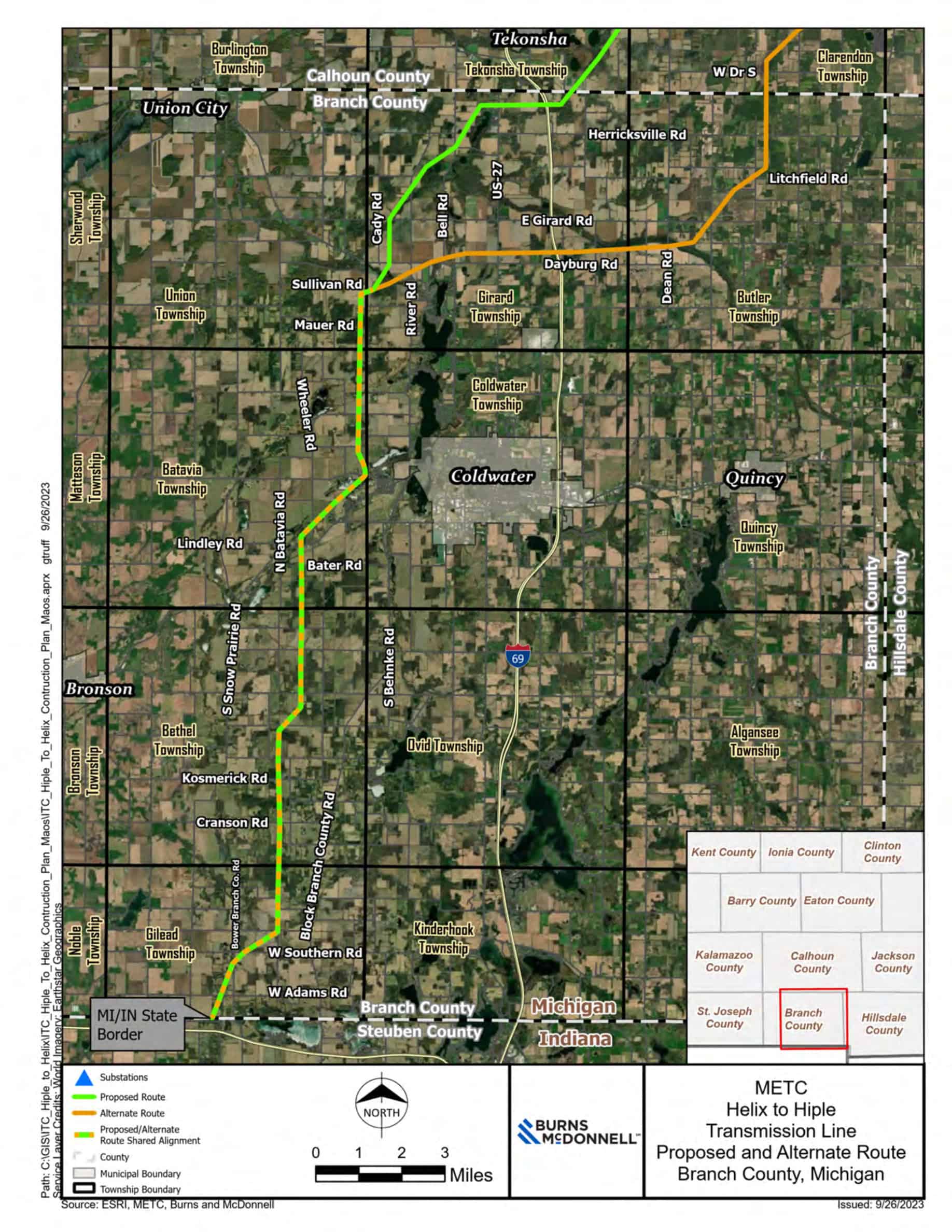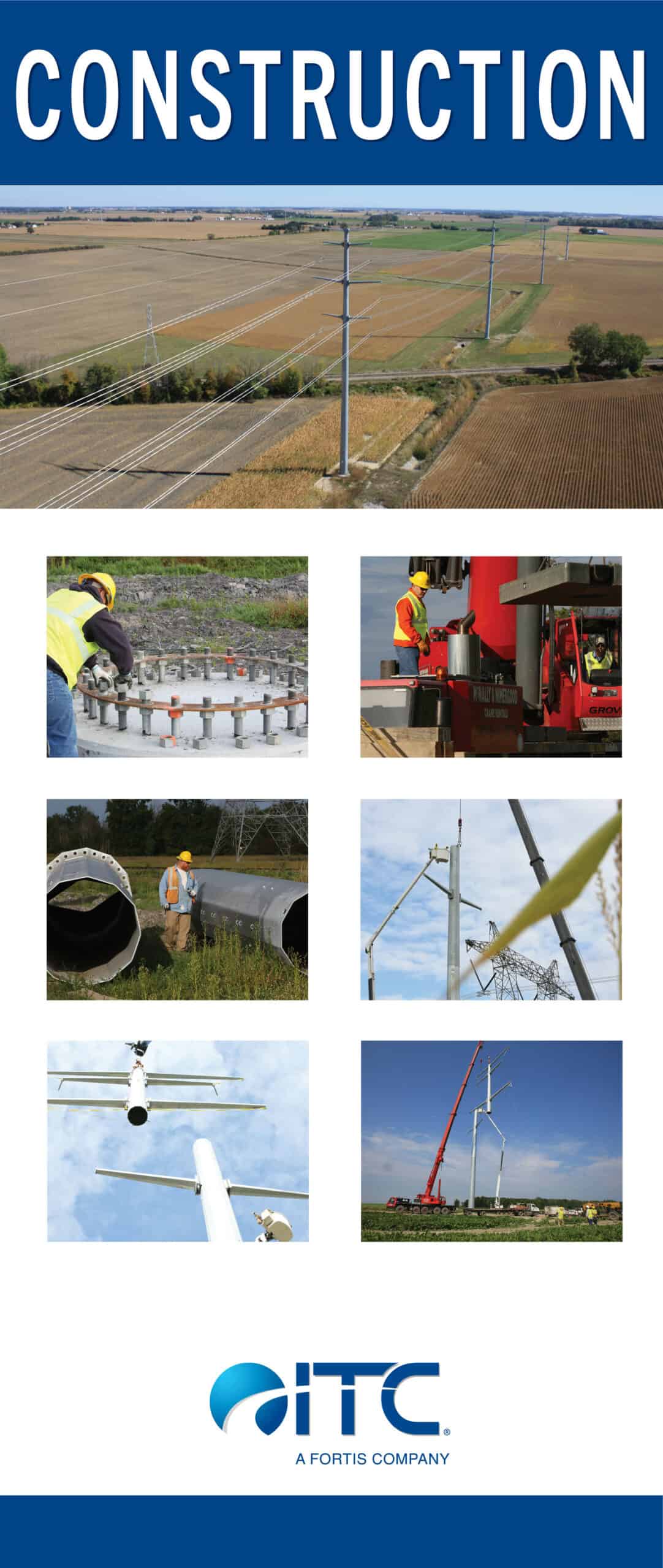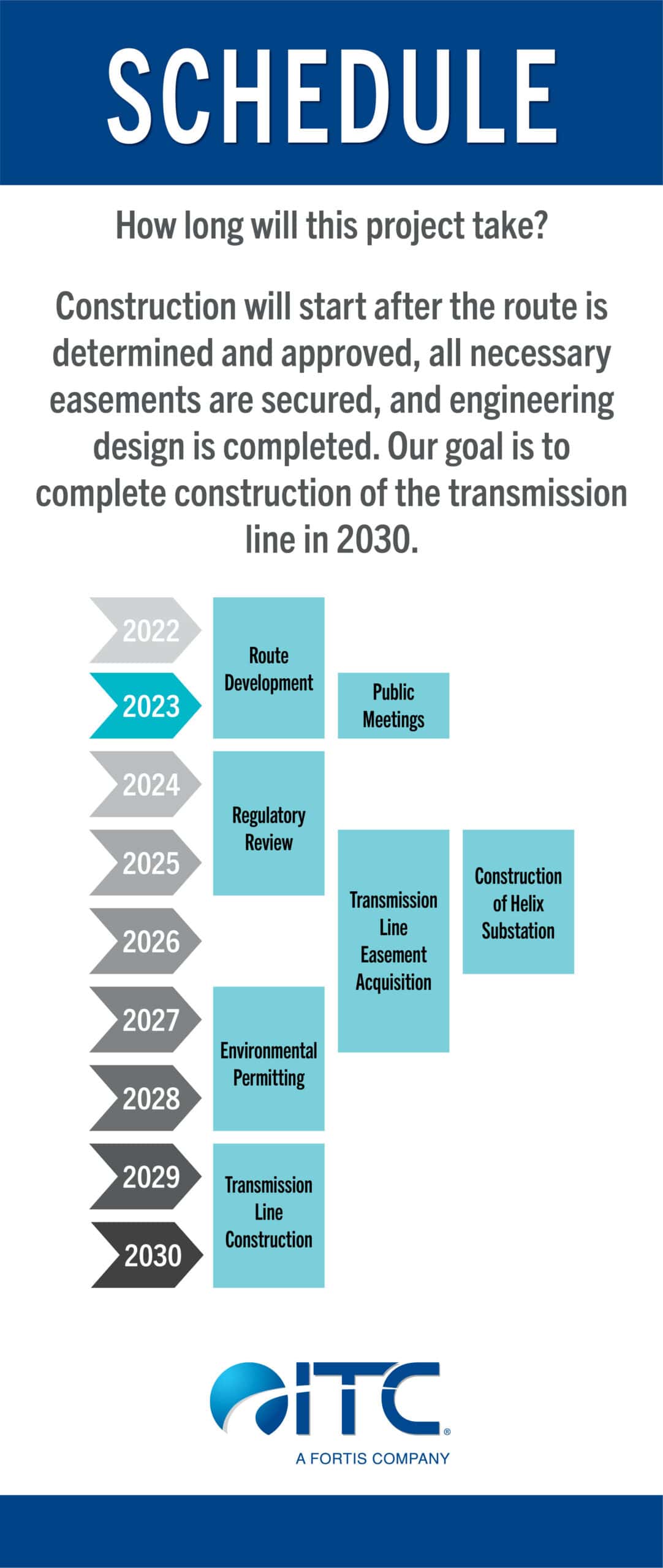Helix to Hiple Information
Who is ITC?
ITC is a vital part of the electrical power system. Headquartered in Michigan – with utility status in 8 states – ITC builds, operates, and maintains the system of high-voltage power lines and substations that transport electricity from power generation sources to local distribution networks and, ultimately, to consumers. Essentially, ITC moves electricity from where it’s made, to where it’s needed.
ITC does not own any power plants or generation facilities, but we constantly respond to changes in our state as demand for power changes. Here are some other key reasons why ITC invests in transmission infrastructure:
- Reliability and Resiliency: Investing in transmission infrastructure helps ensure a reliable and resilient electricity grid. Upgrading and expanding transmission lines improves the overall stability of the system, improves reliability, and provides grid resilience during extreme weather.
- Meet Growing Demand: Transmission infrastructure investments accommodate the increasing demand for electricity. As populations grow and new technologies emerge, the demand for power rises. Expanding the transmission system allows for the efficient and reliable delivery of electricity to meet the needs of homes, businesses, and industries.
- Support Carbon Reduction Goals: Investing in transmission infrastructure supports the integration of a variety of energy sources onto the grid. Getting that electricity from one place to another requires electric transmission infrastructure.
- Economic Benefits: Transmission infrastructure investments stimulate economic growth and job creation. The construction and maintenance of transmission lines require a skilled workforce and support industries, contributing to local economies. Additionally, a reliable transmission system attracts businesses and industries that rely on a stable power supply for their operations.
- Grid Modernization: Upgraded transmission lines can support the implementation of advanced monitoring, control, and communication systems. These technologies enable more efficient grid operation, better utilization of existing assets, and faster identification and resolution of issues.
By investing in transmission infrastructure, ITC provides a reliable, resilient, and modernized electricity grid that can meet the evolving needs of its customers, support carbon reduction goals, and contribute to the economic well-being of the communities it serves.
Project Overview
Responding to the needs of the changing energy landscape, the Midcontinent Independent System Operator (MISO), the grid planning organization for our region, has devoted several years of intensive, collaborative effort to develop a Long-Range Transmission Plan (LRTP). This plan identified the need to build additional high-voltage transmission infrastructure across the region to maintain the long-term reliability and stability of the electric grid.
ITC has responsibility for building the Michigan portion of LRTP:
- Helix-Hiple: ITC will be making infrastructure improvements by building the Michigan portion of the new Helix-Hiple transmission line, spanning approximately 50 miles from the Michigan/Indiana border in Branch County to the new Helix Substation in Calhoun County.
- Nelson Rd-Oneida: Approximately 40 miles of new 345kV electric transmission lines will be built from ITC’s Nelson Rd substation in Gratiot County to the Oneida substation in Eaton County.
The LRTP projects planned for Michigan include approximately 90 miles of new 345kV transmission lines and a total estimated investment of $850 million in Michigan.
Benefits of the Project
LRTP is an important step in modernizing the electric grid and meeting the challenges of a rapidly changing energy landscape. It aligns with state and federal goals to transition towards cleaner and more sustainable energy sources while ensuring a reliable and secure power supply for the residents and businesses of Michigan. LRTP aims to achieve several important outcomes:
- Improve system reliability
- Enhance grid resilience during extreme weather
- Reduce system congestion
- Improve distribution of low-cost, renewable energy
- Reduce carbon emissions to help meet decarbonization goals
- Strategically engineered to support our clean energy transition
ITC’s Role
ITC plays a pivotal role in the MISO LRTP Projects in Michigan. As a leading, independent transmission operator, ITC will be responsible for the planning, development, and construction of the transmission expansion and upgrades across the state. ITC will work closely with regulatory authorities, utilities, and other stakeholders to ensure the successful execution of the projects.
ITC’s expertise in building and operating high-voltage transmission systems will be instrumental in achieving the project’s objectives. ITC aims to contribute to Michigan’s energy future by fostering a robust, reliable, and resilient, power grid to meet Michigan’s energy needs.
Routing/Design
The route selection process generally involves comparing potential routing options.
There are several factors that ITC looks at when routing a transmission line. They include several Engineering, Social, and Environmental factors. These can include criteria such as length, line angles, nearby residences or public facilities, wetland areas, historical and archaeological sites, and cropland/center pivot irrigation presence.
We are committed to securing a route that meets the project needs while minimizing the amount of human and environmental impact.
The “Project Area” was delineated by identifying the project endpoints and allowing for enough geographic diversity between and around these areas so that numerous route options could be identified and studied.
Our routing methodology generally includes the following:
- The project area is identified
- Data is collected and mapped
- Potential route segments are identified throughout the project area (route options)
- The route options are analyzed and comparatively evaluated to determine those that best minimized overall potential impact and best adhered to the routing criteria
- Our routing objective is to identify a feasible Proposed and Alternate Route that:
- Minimize the potential for impact overall
- Can be permitted
- Can be constructed
- Are cost effective
Potential Routes
During planning, ITC recognized the need to create 50 miles of line extending from the new Helix substation to the existing Hiple substation. ITC has identified potential route options that would meet the project purpose.
The initial analysis determined locations that minimize impacts to sensitive resource areas, and would also maximize the use of existing siting opportunities, including existing transmission lines and substations.
The following map uses geographic information system (GIS) technology to allow the agencies and public to view the project area. The intended route can be viewed on aerial imagery illustrating the existing landscape in the region. Please note, this route is conceptual and does not represent final locations or design.
Click on the maps below to learn more:
Environmental
Environmental responsibility is one of ITC’s core values and it is reflected by our employees, at our facilities and in our operations.
Environmental considerations are made at all stages of a transmission line’s lifecycle – from planning and siting processes through construction and maintenance activities, we work to ensure the safe and reliable delivery of power in a responsible way that helps protect the environment.
By considering and addressing potential impacts proactively, an ITC transmission project can lead to a cleaner, more resilient, and environmentally conscious energy landscape.
- Enhanced Biodiversity: Through thoughtful planning and habitat restoration efforts, LRTP can lead to the creation of new ecological corridors, fostering the growth of diverse and native plant and animal species.
- Sustainable Land Use: By adhering to environmentally responsible practices and minimizing land disturbance, LRTP can promote sustainable land use and preserve valuable natural resources.
- Erosion Control: The project will include measures to mitigate soil erosion, protecting nearby water bodies and supporting a healthier ecosystem.
- Renewable Energy Integration: Transmission lines facilitate the integration of renewable energy sources, such as wind and solar, promoting cleaner and greener energy options.
- Public Awareness: The visual presence of transmission structures can serve as a reminder of the importance of energy infrastructure and the transition towards a more sustainable future.
Construction & Schedule
Clearing and Grading:
- The construction phase begins with clearing the designated route of vegetation and obstructions.
- Grading the corridor ensures a smooth and even terrain for the transmission line infrastructure.
- ITC takes care to minimize the impact on the natural environment during this process and restores any disturbed areas after construction.
Foundation and Structure Installation:
- Skilled construction crews begin by installing the foundations for the transmission structures. These foundations provide a stable base to support the weight and tension of the transmission lines.
- ITC uses advanced engineering techniques to ensure that the structures are appropriately positioned and anchored securely to withstand weather events and loads.
Transmission Line Construction:
- Transmission structures are carefully constructed along the designated route.
- Expert teams handle the installation, ensuring precise alignment and safe construction practices.
- The transmission line’s height is carefully determined to avoid potential obstacles and maintain safe clearances. The height will be approximately between 120 ft – 160 ft
Conductors and Insulators:
- High-quality conductors, chosen for their conductivity and durability, are strung between the transmission structures.
- Insulators are installed to prevent electricity from grounding through the structures and to maintain safe electrical isolation.
Crossings and Obstacles:
- In cases where the transmission line needs to cross rivers, roads, or other obstacles, ITC uses specialized engineering techniques.
- Crossings are designed to ensure structural integrity and prevent any interference with existing infrastructure.
- Transmission line routes are designed from Station A to Station B using a variety of factors. Road right of way and existing utility corridors are considered.
Substation Construction:
- With the engineering plans, permits and equipment in place, construction work would begin. This involves site preparation, foundation construction, and equipment installation.
- The substation undergoes comprehensive testing to ensure that all systems are functioning correctly and safely. Once the testing is successful, the substation is commissioned and integrated into the power grid.
- The substation requires ongoing monitoring, maintenance, and management to ensure reliable electricity transmission.
Safety Measures:
- Safety is a top priority
- Construction crews follow strict safety protocols and receive regular safety training.
- Measures are implemented to protect both workers and the public during construction.
Environmental Mitigation:
- ITC takes measures to minimize environmental impact during the construction process.
- This includes controlling erosion, managing stormwater runoff, and implementing sediment control measures.
- ITC collaborates with environmental experts to protect sensitive habitats and wildlife in the vicinity of the project.
Community Engagement:
- ITC maintains open communication with local communities during construction.
- Regular updates and outreach initiatives keep residents informed about the progress and potential temporary disruptions.
Timelines and Completion:
- The construction phase timeline is carefully planned to ensure efficient progress.
- ITC aims to complete the construction within the projected timeframe, considering various factors like weather conditions and unforeseen events.
- In Ionia, Eaton, Clinton, and Gratiot counties, approximately 40 miles of new 345kV line will be built from Oneida Substation in Grand Ledge to Nelson Road substation in Carson City.
- Construction is scheduled to begin Q1 2028 and be completed by Q4 2028.
- From northern Indiana into Michigan through Branch and Calhoun counties, ITC will be making infrastructure improvements by building approximately 50 miles of new transmission lines from the Indiana border to the new Helix Substation in Calhoun County.
- This will be the first new interstate connection to Michigan’s transmission system in nearly 50 years.
- Construction is scheduled to begin on Helix substation in Q4 2025 and be completed by Q3 2026.
- Line building will start Q1 2029 and end Q4 2030.
The construction phase of building new transmission lines requires meticulous planning, skilled labor, and a strong focus on safety and environmental stewardship. ITC’s commitment to these principles ensures a reliable and efficient power delivery system for the benefit of the community and the region.
Public Outreach
ITC has been conducting extensive agency and public outreach for all its major power lines and substation projects for more than two decades. Input from agencies and the public is essential to the success of each new project we construct and operate to best serve our customers. The information provided will help the community understand the planning process, which includes outreach activities and opportunities to view project information.
Per Michigan Electric Transmission Line Certification Act requirements, a public meeting must be held in each township or city that a potential route traverses. There were 14 meetings in total for the Helix to Hiple transmission line route.
Any questions? Check out our Frequently Asked Questions (FAQs) page.
To learn more about this project, visit MIFutureGrid.com.

